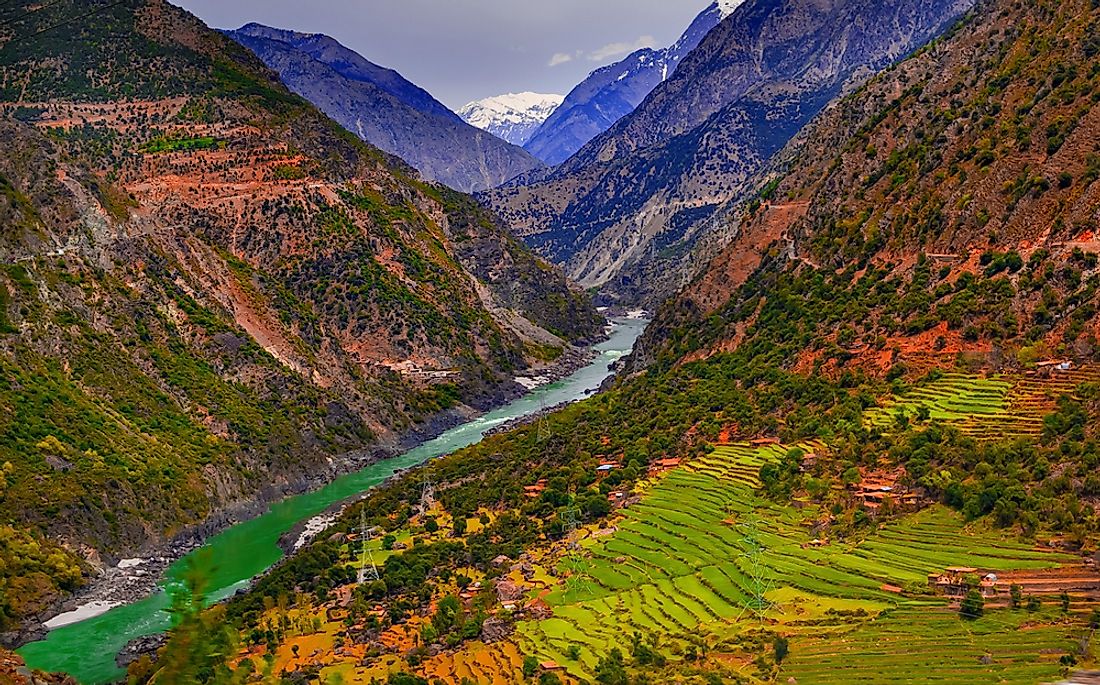Longest Rivers In Pakistan

Pakistan has the lion's share of the Indus, one of the most significant rivers in all of South Asia. Two-thirds of the water supplied for irrigation schemes and in homes comes from the Indus River and its tributaries. The river system of Pakistan originates from the great snow covered Himalayans and the Karakoram Ranges. The rivers then flow to India except the Kabul River that enters Pakistan through Punjab. Pakistan is the 3rd largest agriculturally based economy in the world and rivers are the most important sources of water used in agriculture for irrigation and other domestic uses.
The Indus River
The Indus River is the most important river in southern Asia and it is shared between Pakistan, India, and china. The river runs for about 1,988 miles, from Lake Manasarovar in Tibet to Latah, Gilgit-Baltistan, and Khyber Pakhtunkhwa, then through Punjab to pour to the Arabian Sea near Karachi. The Indus River has a total drainage area of approximately 1,165,000 km2. The river has many tributaries flowing into it. For example the Zanskar River in Latah, Chenab River, and Kabul, Gilgit, Gomal, and Shyok. It is also fed by the rivers from the Himalayas and has a unique ecosystem of temperate forests, lowland plains, and arid countryside. The flow of the river is determined by the season, with the flow being slow in the winter and flooded banks in the monsoon months. The river provides the needed water for Pakistan economy, in the Punjab Province.The river provides the much-needed water to feed Pakistan. The water from the rivers is used in industries and residential homes.
Sutlej
The river flows through India, Pakistan, and China. In Pakistan, it winds through the historic crossroad region of Punjab where it flows through the Vindhya Range, and to the east of central Sulaiman Range. With a length of approximately 901 miles, the river begins from Lake Rakshastal in Tibet and flows to the Shipki La Pass and enters India in Himachal Pradesh province. In Pakistan, the river meets the Chenab River in Bahawalpur and the combined rivers flow to the Indus. The waters of River Sutlej have been tapped for power generation in different points to light both Pakistan and India. The Kol Dam and Baspa Dam are the most prominent projects across Sutlej. The Sutlej river played a vital role in the development of the ancient civilizations of Tibet, and the valley of Garuda holds the remains of Kyunglung Palace. It also played a role in the timber trade of the Hamirpur and Bilaspur where the logs of deodar were transported from one location to another. Cultivation of fruits like grapes, apples, and apricots depended on the water from Sutlej.
Chenab
The Chenab River flows through the towns of Jammu and Kashmir and it is shared between Pakistan and India Unlike other rivers the River originates as two rivers; the Chandra and Bhaga, in the Himalayas which join to form the Chenab River. The Jhelum River joins it at the Trimmu and then merges with the Sutlej in Uch Sharif in Pakistan. It is about 597 miles long. The Chenab Bridge is under construction upon completion it will span the Chenab River with a height of 359 meters. The building of dams along the Chenab River has raised concerns in Pakistan as they fear that water flow will reduce, and this might affect their irrigation schemes.
Jhelum
River Jhelum is approximately 505 miles long and a tributary of river Chenab. The river originates from the southern-eastern part of Kashmir valley, flows through Srinagar and enters Pakistan. The Neelam River pours its water in the Jhelum near Muzaffarabad. There are many dams and barrages constructed on the river Jhelum and Mangla dam was built in 1967 being the largest earth-fill in the world. Barrages on River Jhelum include Rasul and Trimmu barrages. The river has a capacity of about 5.9 million acre-feet.
Kabul
The Kabul River is 435 miles long emerging from the Hindu Kush Mountains in Afghanistan and then emptying to the Indus River in Attock, Pakistan. The major tributaries of Kabul River are the Kunar, Bara, Swat, longer, and Panjshir. In the summer the river swells and floods its banks due to the melting snows in the Hindu Kush. The Kunar tributary carries more water than the Kabul. River Kabul has many dams constructed along its course. In Pakistan, the Warsak Dam which is nearly 20km in the North West city of Peshawar is the most significant. The settlements and town of Kabul take the name from the river.
Sharing The Rivers
Most of the rivers in Pakistan also flow into India. To promote peace and avoid political or social rivalry between the two countries water treaties were signed to determine which waters belong to which country. For example, the Indus Waters Treaty where the waters of Chenab are allocated to Pakistan even though it is a major river in India. India retained the right to use the western waters for non-irrigation projects while Pakistan was to irrigate using the rivers of Jhelum, Chenab, and the Indus. India has control of the Punjab, Sutlej, Beas, and Ravi for irrigation while Pakistan is not allowed to irrigate using these rivers.
Longest Rivers In Pakistan
| Rank | Major Rivers of Pakistan | Total Length |
|---|---|---|
| 1 | Indus | 1,988 miles (shared with India and China) |
| 2 | Sutlej | 901 miles (shared with India and China) |
| 3 | Chenab | 597 miles (shared with India) |
| 4 | Jhelum | 505 miles (shared with India) |
| 5 | Ravi | 447 miles (shared with India) |
| 6 | Kabul | 435 miles (shared with Afghanistan) |
| 7 | Shyok | 342 miles (shared with India) |
| 8 | Kunar | 298 miles (shared with Afghanistan) |
| 9 | Gomal | 249 miles (shared with Afghanistan) |
| 10 | Zhob | 240 miles |







